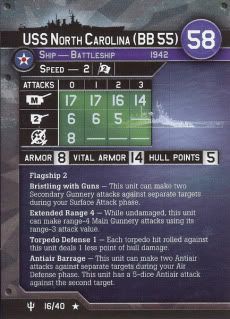War at Sea
Allied Nations
- Australia
- Brazil
- Canada
- France
- Greece
- Netherlands
- New Zealand
- Norway
- Poland
- Soviet Union
- United Kingdom
- United States
- Allies stat table
Axis Nations
Neutral Nations/Installations
Sets
- War At Sea
- Task Force
- Flank Speed
- New Starter
- Condition Zebra
- Set V (Fleet Command)
- Surface action
- First Strike (Forumini Expansion Deck A)
- Infamy (Forumini Expansion Deck B)
- Battle Line (Forumini Expansion Deck C)
- All Hands on Deck (Forumini D)
- Action Stations (Forumini E)
- Dead Reckoning (Forumini F)
Unit Card:

Set - Rarity - Number
Flank Speed - Rare - 16/40
History:
UNC_Samurai
The USS North Carolina represented a significant evolution in U.S. Navy battleship design. Initially authorized in March 1934, it was the first American battleship designed since the First World War and the post-war naval treaty restrictions. The North Carolina incorporated several technological innovations that significantly improved performance and capability compared to dreadnought-era battleships. These included a flush main deck, replacing earlier tripods and cage masts with tall armored superstructures, secondary armament placed in turrets instead of casemates, and engines producing in excess of 115,000 shaft horsepower (Blee 2005:3-4). This engine output almost doubled the performance of the preceding (but canceled) South Dakota-class and the intended 60,000 shaft horsepower output (Newhart 1995:71)
Commissioned in 1941, the vessel was nicknamed “The Showboat” by a New York radio personality as a result of its constant and visually imposing transits into and out of New York Harbor (Blee 2005:39). Transferred to the Pacific Fleet after Pearl Harbor, it served almost the entire war in the Pacific Theater. As with other fast battleships, its primary role in a rapidly evolving Navy was escorting aircraft carriers. The vessel participated in the Guadalcanal, Marianas, Philippines, Iwo Jima, and Okinawa campaigns, and earned 15 battle stars. On 15 September 1942, the North Carolina survived a torpedo hit from the Japanese submarine I-19; the same torpedo salvo sank the carrier Wasp and destroyer O’Brien (Blee 2005:82-85). Following the war, the battleship was briefly used as a training vessel before being decommissioned in 1947.
The North Carolina remained in “mothballs” in Bayonne, New Jersey until the Navy began culling its reserve fleet in the early 1960s. The state of North Carolina mobilized the public in a major preservation fundraising effort (Blee 2005, 145). This included a statewide initiative to have children save coins to donate to the preservation efforts. The North Carolina was moved to a berth across the Cape Fear River from Wilmington in September 1961. The vessel has been maintained as a museum since April 1962, and is operated by the USS North Carolina Battleship Commission.
Reviews:
LuckyE77
North Carolina is the nail in the coffin for her sister Washington. Antiair barrage makes her tough to attack from the air, and with decent guns and flag two makes her one of the best battleships in the game.
Plastic Figure Notes:
BullHalsey
I love the design of this ship. The detail is great and you can see the AA guns and the dual guns but the rear turret sticks and is the only down side, but overall i give it a 9.5/10.
Aran55633
A reprint of Washington…










